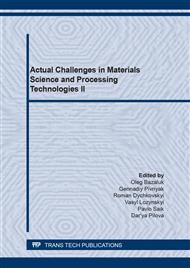[1]
Fischer, H.B., Kryvenko, P.V., & Sanytskyi, M.A. (2013). Study of the Process of Stabilization of Properties of Gypsum Binders. Building Materials and Products, 1, 3-6.
Google Scholar
[2]
Sanytskyi, M.A., & Kondratieva, N.V. (2016). Nanomodified gypsum binders. Modern Trends in the Development and Production of Silicate Materials, 93-95.
Google Scholar
[3]
Potapova. E., & Manushina, A. (2015). Influence of the modifying additives on properties of the gipsum cement-puzzolanic binder. Ibausil, 675-683.
Google Scholar
[4]
Plugin, A.A., Plugin, O.A., Fisher, H.B., & Shabanova, G.N. (2011). Increase of gypsum water resistance by mineral additives. Tagungsbericht, 435.
Google Scholar
[5]
Cheng, C., Li, S., Thomas, A., Kotov, N.A., & Haag, R. (2017). Functional graphene nanomaterials based architectures: biointeractions, fabrications, and emerging biological applications. Chemical reviews, 117(3), 1826-1914.
DOI: 10.1021/acs.chemrev.6b00520
Google Scholar
[6]
Babuschkin, W.I., Matwejew, G.M., & Mtschedlow-Petrosjan, О.P. (1986). Thermodynamik der Silikate. Moscow, Strojizdat, 407.
Google Scholar
[7]
Fischer, H.B., Schlenkina, S.S., & Garkawi, М.S. (2000). Forschung des Prozesses der Alterung der Gipsbinder. Baumaterialen und Erzeugnisse. Magnitogorsk, 43-50.
Google Scholar
[8]
Kartel, N.T., & Lobanov, V.V. (2015). Surface Physics and Chemistry. Book I. Surface Physics. Kyiv, A.A. Chuiko Institute of Surface Chemistry of NAS of Ukraine, Interservis LLC, 588.
DOI: 10.15407/scine13.02.053
Google Scholar
[9]
Derevianko, V., Kondratieva, N., Sanitskiy, N., & Hryshko, H. (2016). Investigation of nano-modified hemihydrate calcium sulfate hydration processes. Meridian Ingineresc, (4), 37-41.
Google Scholar
[10]
Derevianko, V. M., Kondratieva, N. V., & Hryshko, H. M. (2018). The effect of carbon nanotube additives on the structure and properties of calcium sulfate hemihydrate. Journal of Odessa State Academy of Civil Engineering and Architecture, (71), 89-93.
Google Scholar
[11]
Gordina, A.F., Tokarev, Yu.V., Yakovlev, G.I., Kerene, Ya., & Spudulis, E. (2013). Differences in structure formation of gypsum binder modified with carbon nanotubes and lime, Building Materials, 2, 34-37.
Google Scholar
[12]
Derevyanko, VN., Moroz, L.V., Moroz, V.Y., Kushnerova, L.A., & Gryshko, A.N. (2017). Non-modified gypsum binder. Construction, material science, mechanical engineering. Series: Starodubovskiye chteniya, 96, 73-78.
Google Scholar
[13]
Derevianko, V., Kondratieva, N., & Hryshko, H. (2018). Study of impact factors and the mechanism of gypsum binder hydration process in the presence of nanomodifiers. French-Ukrainian Journal of Chemistry, 6(1), 92-100. https://doi.org/10.17721/fujcv6i1p92-100.
DOI: 10.17721/fujcv6i1p92-100
Google Scholar
[14]
Derevyanko, V.Н., & Gryshko, A.N. (2017). Influence of nanomodifiers on physical and mechanical properties of gypsum binders. Vestnik of Prydniprovska State Academy of Civil Engineering and Architecture, 2, 62-67.
Google Scholar
[15]
Derevianko, V.M., Hryshko, H.M., & Moroz, W.Y. (2018). The effect of nanoadditives on the hydration of gypsum binding agents. Collected Scientific Works of Ukrainian State University of Railway Transport, (178). https://doi.org/10.18664/1994-7852.178.2018.138994.
DOI: 10.18664/1994-7852.178.2018.138994
Google Scholar
[16]
Paschenko, A.A., Serbin, V.P., Starchevskaya, E.A. (1985). Binders. Kyiv, Vyshcha Shkola, 440.
Google Scholar


